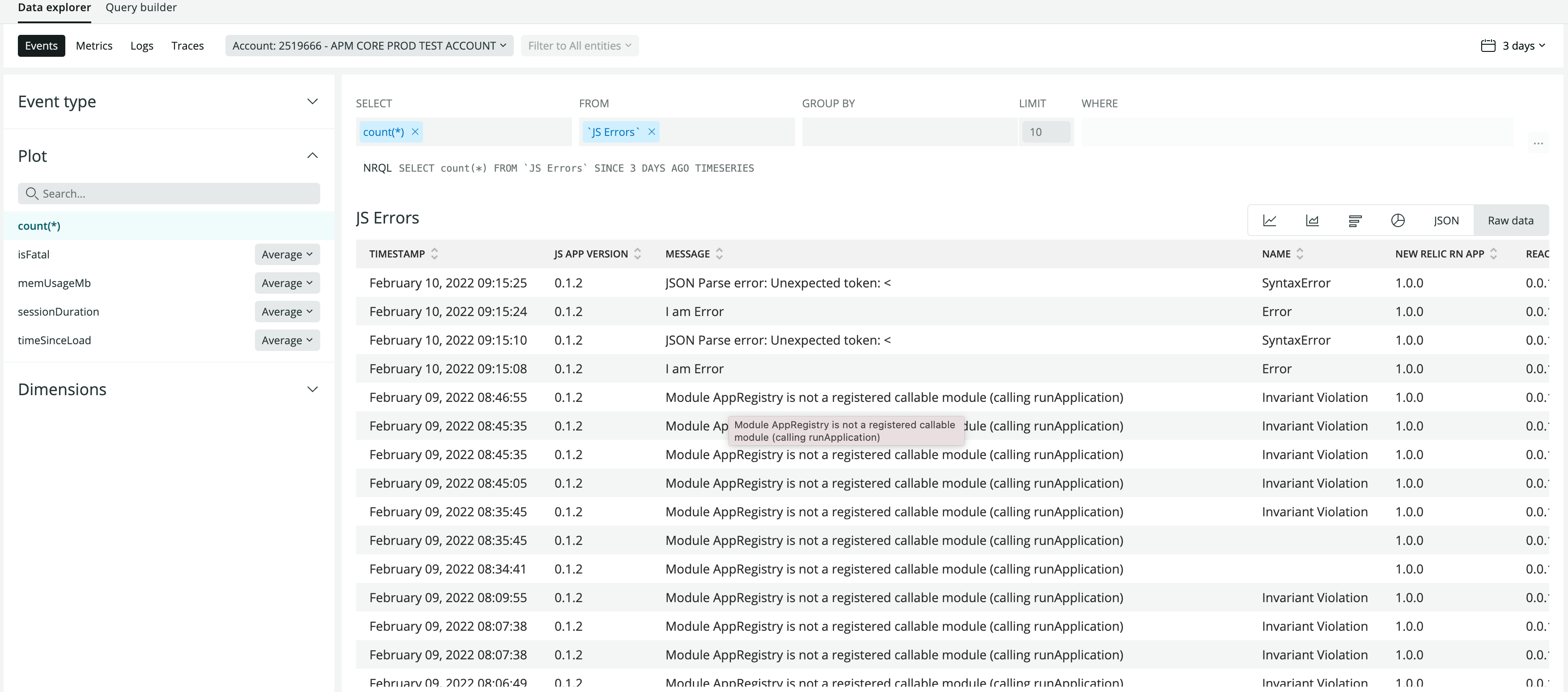This agent uses native New Relic Android and iOS agents to instrument the React-Native Javascript environment. The New Relic SDKs collect crashes, network traffic, and other information for hybrid apps using native components.
NOTE: This agent SDK is not yet officially supported. If you’re interested in participating in our early access program, contact Support or your account representative.
- Capture JavaScript errors
- Network Instrumentation
- Distributed Tracing
- Tracking console log, warn and error
- Promise rejection tracking
- Capture interactions and the sequence in which they were created
- Pass user information to New Relic to track user sessions
- Expo Support (Bare Workflow & Managed Workflow)
- Android API 21+
- iOS 10
- Depends on New Relic iOS/XCFramework and Android agents
Native support levels are based on React Native requirements.
- React Native >= 0.61
- IOS native requirements
- Android native requirements
Yarn
yarn add newrelic-react-native-agentNPM
npm i newrelic-react-native-agentNow open your index.js and add the following code to launch NewRelic (don't forget to put proper application tokens):
import NewRelic from 'newrelic-react-native-agent';
import * as appVesrion from './package.json';
import {Platform} from 'react-native';
let appToken;
if (Platform.OS === 'ios') {
appToken = '<IOS-APP-TOKEN>';
} else {
appToken = '<ANDROID-APP-TOKEN>';
}
NewRelic.startAgent(appToken);
NewRelic.setJSAppVersion(appVesrion.version);
AppToken is platform-specific. You need to generate the seprate token for Android and iOS apps.
- Install the New Relic native Android agent (instructions here).
- Update
build.gradle:
buildscript {
...
repositories {
...
mavenCentral()
}
dependencies {
...
classpath "com.newrelic.agent.android:agent-gradle-plugin:6.5.0"
}
}- Update
app/build.gradle:
apply plugin: "com.android.application"
apply plugin: 'newrelic' // <-- add this
- Make sure your app requests INTERNET and ACCESS_NETWORK_STATE permissions by adding these lines to your
AndroidManifest.xml
<uses-permission android:name="android.permission.INTERNET" />
<uses-permission android:name="android.permission.ACCESS_NETWORK_STATE" />
Run the following, and it will install the New Relic XCFramework agent:
npx pod-install- Once the above steps have been completed, the React Native NewRelic library must be linked to your project and your application needs to be rebuilt. If you use React Native 0.60+, you automatically have access to "autolinking," requiring no further manual installation steps.
To automatically link the package, rebuild your project:
# Android apps
npx react-native run-android
# iOS apps
cd ios/
pod install --repo-update
cd ..
npx react-native run-iosIf you run following commands then Fatal JS erros will show up as a crash in NR.
npx react-native run-ios --configuration Release
npx react-native run-android --variant=release
Integration with Expo is possible in both bare workflow and custom managed workflow via config plugins.
- Bare Workflow: Please follow the above installation steps instead.
- Managed Workflow: After installing our package, add the config plugin to the plugins array of your
app.jsonorapp.config.js.
{
"name": "my app",
"plugins": ["newrelic-react-native-agent"]
}
After this, you need to use the expo prebuild --clean command as described in the "Adding custom native code"guide to rebuild your app with the plugin changes. If this command is not running, you'll get errors when starting the New Relic agent.
See the examples below, and for more detail, see New Relic IOS SDK doc or Android SDK.
startInteraction(interactionName: string): Promise<InteractionId>;
Track a method as an interaction.
InteractionId is string.
setInteractionName(interactionName: string): void;
Name or rename interaction (Android-specific).
endInteraction(id: InteractionId): void;
End an interaction (Required). This uses the string ID for the interaction you want to end. This string is returned when you use startInteraction().
var HttpDemo_id = NewRelic.startInteraction("HttpDemo");
return(
<View style = {main.container}>
<Text>Select the below buttons. Background your application and the data will arrive in NR.</Text>
<Button style = {button_blue.blue} title="Good Http Request" onPress= {() => goodRequest()} />
<Button style = {button_blue.blue} title="Bad Http Request" onPress = {() => badRequest()} />
</View>
);
NewRelic.endInteraction(HttpDemo_id);
setAttribute(name: string, value: boolean | number | string): void;
Creates a session-level attribute shared by multiple mobile event types. Overwrites its previous value and type each time it is called.
NewRelic.setAttribute('RNCustomAttrNumber', 37);
setUserId(userId: string): void;
Set a custom user identifier value to associate user sessions with analytics events and attributes.
NewRelic.setUserId("RN12934");
recordBreadcrumb(name: string, attributes?: {[key: string]: boolean | number | string}): void;
Track app activity/screen that may be helpful for troubleshooting crashes.
NewRelic.recordBreadcrumb("shoe", {"shoeColor": "blue","shoesize": 9,"shoeLaces": true});
recordCustomEvent(eventType: string, eventName?: string, attributes?: {[key: string]: boolean | number | string}): void;
Creates and records a custom event for use in New Relic Insights.
NewRelic.recordCustomEvent("mobileClothes", "pants", {"pantsColor": "blue","pantssize": 32,"belt": true});
There is no section for JavaScript errors, but you can see JavaScript errors in custom events and also query them in NRQL explorer.
You can also build dashboard for errors using this query:
SELECT jsAppVersion,name,Message,errorStack,isFatal FROM `JS Errors` SINCE 24 hours agoCurrently there is no symbolication of Javascript errors. Please follow the steps described here for Symbolication.
* IMPORTANT considerations and best practices include:
*
* - You should limit the total number of event types to approximately five.
* eventType is meant to be used for high-level categories.
* For example, you might create an event type Gestures.
*
* - Do not use eventType to name your custom events.
* Create an attribute to name an event or use the optional name parameter.
* You can create many custom events; it is only event types that you should limit.
*
* - Using the optional name parameter has the same effect as adding a name key in the attributes dictionary.
* name is a keyword used for displaying your events in the New Relic UI.
* To create a useful name, you might combine several attributes.

